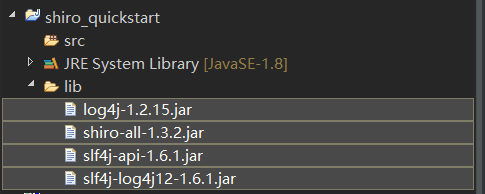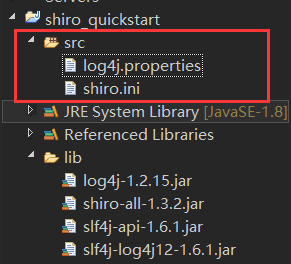测试shiro的quickstart
来源:互联网 发布:淘宝直播卖什么最好卖 编辑:程序博客网 时间:2024/06/08 05:15
第一步:新建Java工程shiro_quickstart,新建lib文件夹,导入jar文件:

在src目录下新建文件log4j.properties:
## Licensed to the Apache Software Foundation (ASF) under one# or more contributor license agreements. See the NOTICE file# distributed with this work for additional information# regarding copyright ownership. The ASF licenses this file# to you under the Apache License, Version 2.0 (the# "License"); you may not use this file except in compliance# with the License. You may obtain a copy of the License at## http://www.apache.org/licenses/LICENSE-2.0## Unless required by applicable law or agreed to in writing,# software distributed under the License is distributed on an# "AS IS" BASIS, WITHOUT WARRANTIES OR CONDITIONS OF ANY# KIND, either express or implied. See the License for the# specific language governing permissions and limitations# under the License.#log4j.rootLogger=INFO, stdoutlog4j.appender.stdout=org.apache.log4j.ConsoleAppenderlog4j.appender.stdout.layout=org.apache.log4j.PatternLayoutlog4j.appender.stdout.layout.ConversionPattern=%d %p [%c] - %m %n# General Apache librarieslog4j.logger.org.apache=WARN# Springlog4j.logger.org.springframework=WARN# Default Shiro logginglog4j.logger.org.apache.shiro=TRACE# Disable verbose logginglog4j.logger.org.apache.shiro.util.ThreadContext=WARNlog4j.logger.org.apache.shiro.cache.ehcache.EhCache=WARN在src目录下新建文件shiro.ini:
## Licensed to the Apache Software Foundation (ASF) under one# or more contributor license agreements. See the NOTICE file# distributed with this work for additional information# regarding copyright ownership. The ASF licenses this file# to you under the Apache License, Version 2.0 (the# "License"); you may not use this file except in compliance# with the License. You may obtain a copy of the License at## http://www.apache.org/licenses/LICENSE-2.0## Unless required by applicable law or agreed to in writing,# software distributed under the License is distributed on an# "AS IS" BASIS, WITHOUT WARRANTIES OR CONDITIONS OF ANY# KIND, either express or implied. See the License for the# specific language governing permissions and limitations# under the License.## =============================================================================# Quickstart INI Realm configuration## For those that might not understand the references in this file, the# definitions are all based on the classic Mel Brooks' film "Spaceballs". ;)# =============================================================================# -----------------------------------------------------------------------------# Users and their assigned roles## Each line conforms to the format defined in the# org.apache.shiro.realm.text.TextConfigurationRealm#setUserDefinitions JavaDoc# -----------------------------------------------------------------------------[users]# user 'root' with password 'secret' and the 'admin' roleroot = secret, admin# user 'guest' with the password 'guest' and the 'guest' roleguest = guest, guest# user 'presidentskroob' with password '12345' ("That's the same combination on# my luggage!!!" ;)), and role 'president'presidentskroob = 12345, president# user 'darkhelmet' with password 'ludicrousspeed' and roles 'darklord' and 'schwartz'darkhelmet = ludicrousspeed, darklord, schwartz# user 'lonestarr' with password 'vespa' and roles 'goodguy' and 'schwartz'lonestarr = vespa, goodguy, schwartz# -----------------------------------------------------------------------------# Roles with assigned permissions# # Each line conforms to the format defined in the# org.apache.shiro.realm.text.TextConfigurationRealm#setRoleDefinitions JavaDoc# -----------------------------------------------------------------------------[roles]# 'admin' role has all permissions, indicated by the wildcard '*'admin = *# The 'schwartz' role can do anything (*) with any lightsaber:schwartz = lightsaber:*# The 'goodguy' role is allowed to 'drive' (action) the winnebago (type) with# license plate 'eagle5' (instance specific id)goodguy = winnebago:drive:eagle5 其中,[users]和[roles]定义了用户和角色,这会在下面的测试代码中用到。
在[users]下,lonestarr = vespa, goodguy, schwartz代表的意义是:用户lonestarr的凭证(密码)是vespa,该用户含有goodguy和schwartz这两个角色。
在[roles]下,goodguy = winnebago:drive:eagle5代表的意义是:允许角色goodguy对类型为winnebago的实体eagle5执行drive操作。
新建好文件后的工程如下图所示:

第二步:新建包com.shiro.test,在该包下新建类Quickstart.java:
package com.shiro.test;import org.apache.shiro.SecurityUtils;import org.apache.shiro.authc.*;import org.apache.shiro.config.IniSecurityManagerFactory;import org.apache.shiro.mgt.SecurityManager;import org.apache.shiro.session.Session;import org.apache.shiro.subject.Subject;import org.apache.shiro.util.Factory;import org.slf4j.Logger;import org.slf4j.LoggerFactory;/** * Simple Quickstart application showing how to use Shiro's API. * * @since 0.9 RC2 */public class Quickstart { private static final transient Logger log = LoggerFactory.getLogger(Quickstart.class); public static void main(String[] args) { // The easiest way to create a Shiro SecurityManager with configured // realms, users, roles and permissions is to use the simple INI config. // We'll do that by using a factory that can ingest a .ini file and // return a SecurityManager instance: // Use the shiro.ini file at the root of the classpath // (file: and url: prefixes load from files and urls respectively): Factory<SecurityManager> factory = new IniSecurityManagerFactory("classpath:shiro.ini"); SecurityManager securityManager = factory.getInstance(); // for this simple example quickstart, make the SecurityManager // accessible as a JVM singleton. Most applications wouldn't do this // and instead rely on their container configuration or web.xml for // webapps. That is outside the scope of this simple quickstart, so // we'll just do the bare minimum so you can continue to get a feel // for things. SecurityUtils.setSecurityManager(securityManager); // Now that a simple Shiro environment is set up, let's see what you can do: // get the currently executing user: // 获取当前的 Subject. 调用 SecurityUtils.getSubject(); Subject currentUser = SecurityUtils.getSubject(); // Do some stuff with a Session (no need for a web or EJB container!!!) // 测试使用 Session // 获取 Session: Subject#getSession() Session session = currentUser.getSession(); session.setAttribute("someKey", "aValue"); String value = (String) session.getAttribute("someKey"); if (value.equals("aValue")) { log.info("---> Retrieved the correct value! [" + value + "]"); } // let's login the current user so we can check against roles and permissions: // 测试当前的用户是否已经被认证. 即是否已经登录. // 调动 Subject 的 isAuthenticated() if (!currentUser.isAuthenticated()) { // 把用户名和密码封装为 UsernamePasswordToken 对象 UsernamePasswordToken token = new UsernamePasswordToken("lonestarr", "vespa"); // rememberme token.setRememberMe(true); try { // 执行登录. currentUser.login(token); } // 若没有指定的账户, 则 shiro 将会抛出 UnknownAccountException 异常. catch (UnknownAccountException uae) { log.info("----> There is no user with username of " + token.getPrincipal()); return; } // 若账户存在, 但密码不匹配, 则 shiro 会抛出 IncorrectCredentialsException 异常。 catch (IncorrectCredentialsException ice) { log.info("----> Password for account " + token.getPrincipal() + " was incorrect!"); return; } // 用户被锁定的异常 LockedAccountException catch (LockedAccountException lae) { log.info("The account for username " + token.getPrincipal() + " is locked. " + "Please contact your administrator to unlock it."); } // ... catch more exceptions here (maybe custom ones specific to your application? // 所有认证时异常的父类. catch (AuthenticationException ae) { //unexpected condition? error? } } //say who they are: //print their identifying principal (in this case, a username): log.info("----> User [" + currentUser.getPrincipal() + "] logged in successfully."); //test a role: // 测试是否有某一个角色. 调用 Subject 的 hasRole 方法. if (currentUser.hasRole("schwartz")) { log.info("----> May the Schwartz be with you!"); } else { log.info("----> Hello, mere mortal."); return; } //test a typed permission (not instance-level) // 测试用户是否具备某一个行为. 调用 Subject 的 isPermitted() 方法。 if (currentUser.isPermitted("lightsaber:weild")) { log.info("----> You may use a lightsaber ring. Use it wisely."); } else { log.info("Sorry, lightsaber rings are for schwartz masters only."); } //a (very powerful) Instance Level permission: // 测试用户是否具备某一个行为. if (currentUser.isPermitted("winnebago:drive:eagle5")) { log.info("----> You are permitted to 'drive' the winnebago with license plate (id) 'eagle5'. " + "Here are the keys - have fun!"); } else { log.info("Sorry, you aren't allowed to drive the 'eagle5' winnebago!"); } //all done - log out! // 执行登出. 调用 Subject 的 Logout() 方法. System.out.println("---->" + currentUser.isAuthenticated()); currentUser.logout(); System.out.println("---->" + currentUser.isAuthenticated()); System.exit(0); }}第三步:运行程序,可以在控制台打印出相应的测试信息。
0 0
- 测试shiro的quickstart
- Shiro Quickstart
- Shiro QuickStart使用shiro.ini静态数据源实现权限管理
- Quickstart
- 第一个Shiro(Quickstart)来自官网
- Sring MVC 环境下的Shiro集成测试
- ServiceMix - [Quickstart]5.可选的特性
- ServiceMix - [Quickstart]6.我遇到的几个问题
- Eclipse 部署 Springside4 的quickstart 实例
- springside quickstart查询中文乱码的解决
- Redis 和Python Client的QuickStart
- AngularJS学习之一:AngularJS的QUICKSTART
- eclipse 欲仙欲死的quickstart.jar 和catalog
- shiro-03shiro的filterChainDefinitions
- shiro-04shiro的缓存
- Apache shiro测试及其原理
- 如何安装VS.NET2003中文版自带的QuickStart
- 如何安装VS.NET2003中文版自带的QuickStart
- 327UVa计算简单C表达式
- 修改maven镜像,镜像和仓库的区别
- G++隐藏"bug"及应对:未特化的模板中的static_assert(false)的两种处理方式
- HDU 2054 大数比较
- EntityFramework Core 1.1有哪些新特性呢?我们需要知道
- 测试shiro的quickstart
- SpringBoot 整合Ehcache3
- 比较系统的在线学习网站
- 我为什么选择七牛云存储
- 七牛云存储九折优惠码
- python 7-5 如何让类支持比较操作lt/le/total_ordering可以简化此过程,实现lt eq 后,可以推测出<= >=方法
- 机器学习面试准备之二、优化方法
- 【Leetcode】204. Count Primes
- Nutz | Nutz项目整合Spring实战


